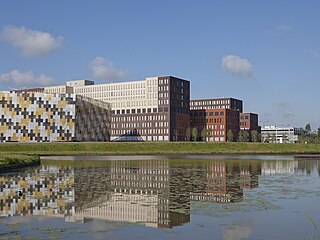
's-Hertogenbosch, German: Herzogenbusch, colloquially known as Den Bosch, is a city and municipality in the Netherlands with a population of 152,968. It is the capital of the province of North Brabant.

North Brabant, also unofficially called Brabant, is a province in the south of the Netherlands. It borders the provinces of South Holland and Gelderland to the north, Limburg to the east, Zeeland to the west, and the Flemish provinces of Antwerp and Limburg to the south. The northern border follows the Meuse westward to its mouth in the Hollands Diep strait, part of the Rhine–Meuse–Scheldt delta. North Brabant has a population of 2,562,566 as of November 2019. Major cities in North Brabant are Eindhoven, Tilburg, Breda and its provincial capital 's-Hertogenbosch.

De Stijl, Dutch for "The Style", also known as Neoplasticism, was a Dutch art movement founded in 1917 in Leiden. De Stijl consisted of artists and architects. In a narrower sense, the term De Stijl is used to refer to a body of work from 1917 to 1931 founded in the Netherlands. Proponents of De Stijl advocated pure abstraction and universality by a reduction to the essentials of form and colour; they simplified visual compositions to vertical and horizontal, using only black, white and primary colors.

Philip Fruytiers (1610–1666) was a Flemish Baroque painter and engraver. Until the 1960s, he was especially known for his miniature portraits in watercolor and gouache. Since then, several large canvases signed with the monogram PHF have been ascribed to him. These new findings have led to a renewed appreciation for his contribution to the Antwerp Baroque.

The Frans Hals Museum is a museum located in Haarlem, the Netherlands.

The Hague School is a group of artists who lived and worked in The Hague between 1860 and 1890. Their work was heavily influenced by the realist painters of the French Barbizon school. The painters of the Hague school generally made use of relatively somber colors, which is why the Hague School is sometimes called the Gray School.

Museum Boijmans Van Beuningen is an art museum in Rotterdam in the Netherlands. It is located at the Museumpark in the district Rotterdam Centrum, close to the Kunsthal and the Natural History Museum.

Amsterdam Impressionism was an art movement in late 19th-century Holland. It is associated especially with George Hendrik Breitner and is also known as the School of Allebé.

Dutch art describes the history of visual arts in the Netherlands, after the United Provinces separated from Flanders. Earlier painting in the area is covered in Early Netherlandish painting and Dutch and Flemish Renaissance painting.

Maria Elisabeth Georgina Ansingh was a Dutch painter.

Kunst zij ons doel, or KZOD, is the name of an artists club in the Waag, Haarlem.

Anton Heyboer was a Dutch painter and printmaker.

The Coomanshof is a former hofje in Haarlem, Netherlands, on the Witte Heren straat.

Johannes Jacobus (Jan) van der Vaart was an influential Dutch ceramist from the 20th century, known as founder of the abstract-geometric ceramics in the Netherlands.

Albertus Johannes (Jan) van Gemert was a Dutch painter, graphic artist, sculptor, glass artist and ceramist.
Daniël (Daan) van Golden was a Dutch artist, who has been active as a painter, photographer, collagist, installation artist, wall painter and graphic artist. He is known for his meticulous paintings of motives and details of everyday life and every day images.

Frans Mortelmans was a Belgian painter, draughtsman and engraver. He initially produced portraits, history paintings, marines and genre scenes but later specialised in still lifes, and in particular flower pieces, with which he achieved considerable success.

Het Noordbrabants Museum is an art museum in 's-Hertogenbosch, Netherlands.

Martine Theodora Bax is a Dutch-Canadian art historian and art critic in modern art. Her specializations are the work of Piet Mondrian and the relationship between art and Western Esotericism, especially Modern Theosophy and Anthroposophy.

The Jeroen Bosch HospitalJeroen Bosch Ziekenhuis or JBZ, is a general hospital in 's-Hertogenbosch. The building at the current location on the Henri Dunantlaan was opened in 2011.




















